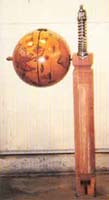Years ago I used to live in Marin County and there was a dump in San Rafael, the old “San Quentin Dump.” It had no relation to the prison. It was just located near it. My son was very young then and he and I used to go to the dump every Saturday and look for stuff. Or as he would say, “find stuff.” And we did. It was extraordinary. Beautiful pieces of windshield glass, toys, mounds of ceramic fixtures, metals, irons, aluminum and tins beyond belief. Wires already shaped into beautiful pieces of sculpture. Furniture. Tire structures beyond belief. TV sets galore. My son found his first big wheel, a chest of drawers, mounds of things to take home and make something out of.
Our house became known as “that second dump.” We were both impressed with the amount of stuff people had, that people threw away and that we could use or were certainly still useful. It was clear that consumption was running rampant. Although the San Quentin dump was, in fact, a dump, it was also a cottage industry where people bought and sold other people’s stuff. Every week we went, it grew and grew and grew. … Our efforts at recycling were fairly ineffectual. I can’t even remember if recycling was a concept then. It really didn’t work to take stuff from one dump simply to another.
I began to think about information, reclamation and reconciliation both as personal and social phenomena, and as an environmental one. As an artist I began to wonder how art could be folded into this mix.
The idea of “artist books” has always intrigued me. The notion of information reclaimed (recycled) from throwaways, transformed and put out in another form, and finally to take on a life of its own out in the world has extraordinary cultural and educational potential, somewhat like a library.
Photos and press release for this artist.
